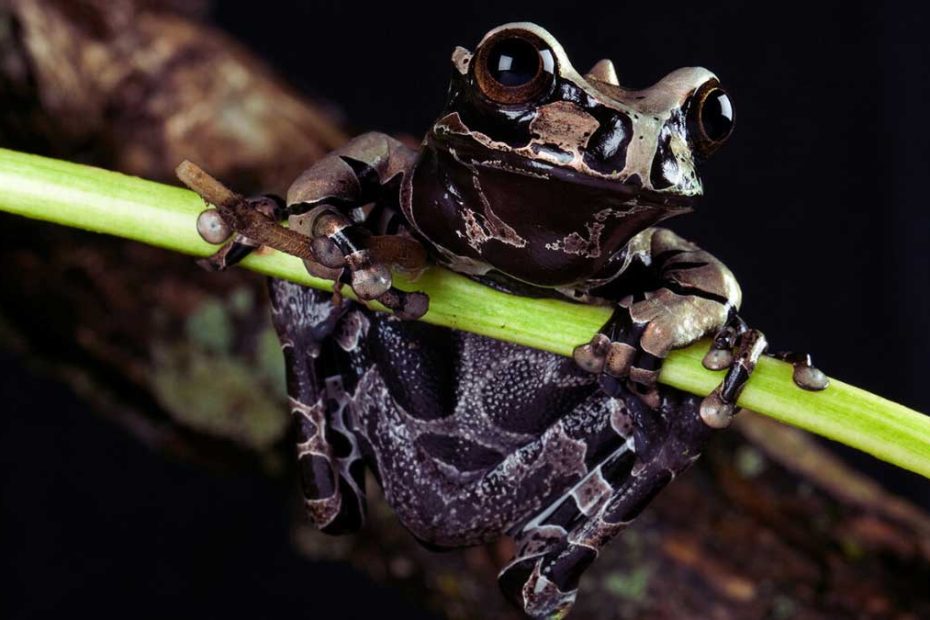The spiny-headed tree frog (Anotheca spinosa) gets its name from the sharp pointed projections on its head. However, juveniles don’t have the projections. This toad is native to Central America and is found in Costa Rica, Panama, Mexico, and Honduras. Its striking skin coloration makes it a beauty and a popular species among photographers, herpetologists, and frog hobbyists.
This article will take a more in-depth look at this Central American unique tree frog species. We’ll discuss everything you need to know about the species including its physical size, sound/call, poisonous characteristics, and lifespan. If you’re interested in keeping this toad as a pet, we will also shed some light on where to buy it, how much you’ll need to spend, and how to take good care of it.
Spiny-headed Tree Frog Overview:
The spiny-headed tree frog (Anotheca spinosa), also known as the crowned tree frog or coroneted tree frog, is the only species under the genus Anotheca.
Its most distinct feature is the spines projecting from the skin on its head.
This frog also features a striking skin pattern characterized by a combination of light brown, dark brown, gray, and white coloration. The underbelly is black with flanks boarded in white.
Note that juveniles lack the projections on their head and usually bear white coloration during hatching. They then transition from dark brown to bluish-gray appearance as they mature.
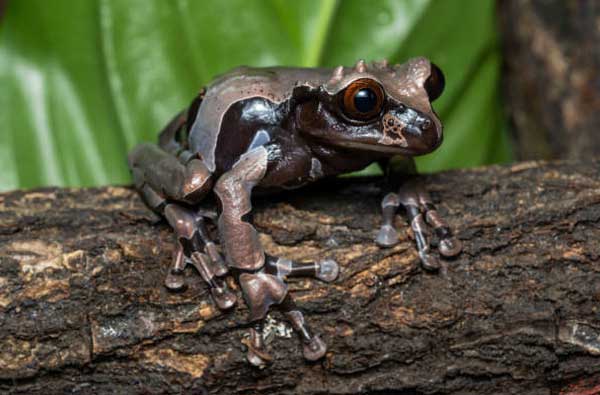
Native habitat for this frog includes fragmented populations in various Central American countries namely Honduras, Panama, Mexico, and Costa Rica. It is found at elevations 95 to 2,000 meters (311 to 6,561 feet) above sea level.
This arboreal frog species is rarely spotted in its habitat as it spends most of its time in bromeliads and various other plants.
In its range, this frog inhabits subtropical forests situated just below the mountainous regions.
Though it stays in intact forests, it is also common in young, secondary-growth types of forests. The frog is also sometimes observed in coffee plantations.
The species is nocturnal, meaning it only comes out at night to forage for food. It mainly eats insects and various other small arthropods. Tadpoles feed on unfertilized eggs that are produced by their mothers.
Breeding for these frogs occurs in areas where water has collected, e.g. on tree holes, bromeliads, or bamboo internodes. Males find suitable egg-laying sites and then make calls to attract the females.
Once females arrive at the breeding site they engage in the amplexus position, during which the female lays her as the male simultaneously fertilizes them externally.
A female can lay between 50 and 300 eggs. Out of these, only 25 eggs have survival chances and usually hatch in 6-7 days.
After the eggs hatch, the female makes regular trips to the site to lay additional unfertilized eggs. These act as food for the larvae. The female simply sits on the water with its cloaca submerged. When the tadpoles suck or touch her, they stimulate her to lay the eggs.
Regarding conservation status, this tree frog is listed as a Near Threatened species by the IUCN Red List.
Key threats it faces in the wild include habitat disturbance and destruction caused by deforestation and diseases such as the amphibian Pathogen Bactrachochytrium dendrobatidis, which causes chytridiomycosis.
Spiny-headed tree frog size
An adult spiny-headed tree frog length from snout to vent is around 2.3 to 3.1 inches (5.8 to 8 cm). Females are generally larger than males. Note that these toads continue growing throughout their lives, so older animals can be even larger.
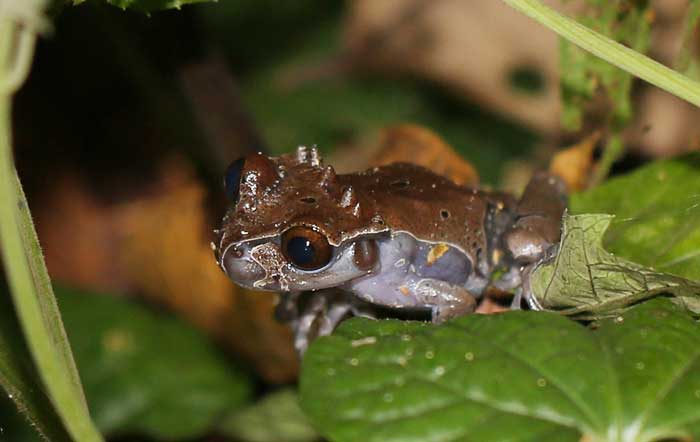
Spiny-headed tree toad sound
The Crowned tree frog call is a loud “boop-boop-boop” sound that can be heard up to 100 meters (300 feet) away. However, note that this tree frog lacks vocal slits and sacs present in most other species.
Spiny-headed tree toad poisonous characteristics
The spiny-headed tree toad is not known to be poisonous or venomous. However, researchers believe it uses its large head spikes as a headgear to deter potential predators.
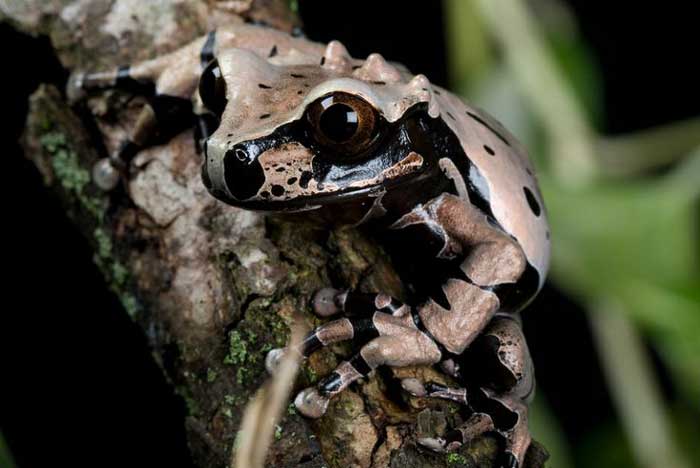
Spiny-headed tree toad lifespan
The spiny-headed tree toad lifespan is believed to be between 10 and 15 years. This is pretty much the same lifespan for most other tree frog species.
Spiny-headed Tree Frog for Sale
When looking for a crowned tree frog for sale, we advise you to consider reputable sources to ensure the well-being of the animal you buy.
Some good options to start your search for this pet frog include exotic animal breeders, reputable pet stores, and online listings.
You may also consider checking local reptile/amphibian expos and online forums that are dedicated to exotic pets.
Alternatively, you can adopt this frog from a rescue organization to provide a home and care for a frog in need.
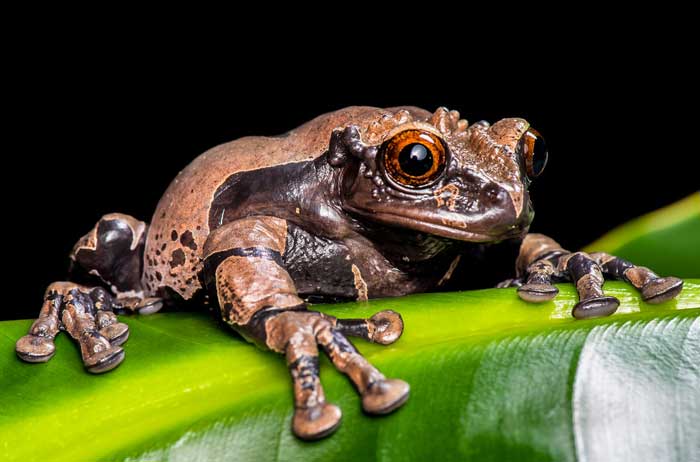
Before you buy your pet, ensure the seller has a positive reputation and adheres to the legal and ethical standards in the trade of exotic species.
When making a purchase, be sure to enquire about the frog’s age, health, specific care requirements, and other helpful info
Above all, check that this species is legal to possess in your area of residence and whether you need any license or permit to keep one.
Spiny-headed Tree Frog Price
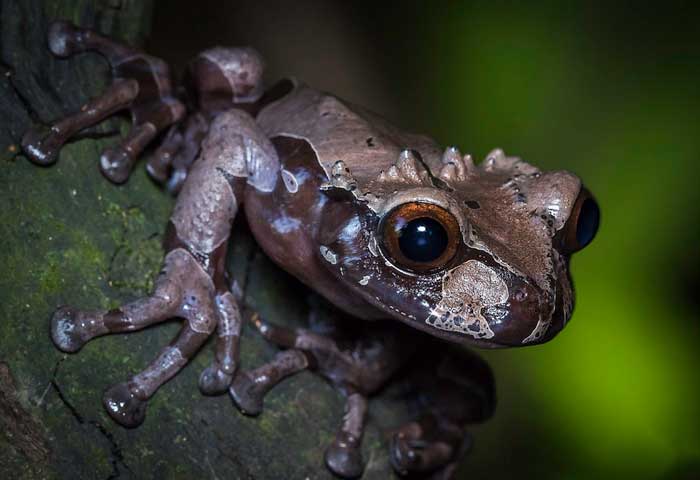
The price for a spiny-headed tree frog can range from $50 to $100 or higher. The reason behind this higher price tag is due to the rarity of this species, which makes it less common in the pet trade.
Other factors that may affect the price of this pet frog include age and sex, source and breeder reputation, market demand, legal restrictions, and import regulations.
Spiny-headed Tree Frog as a Pet
If you’re interested in keeping the spiny-headed tree frog as a pet, then you’ll need to ensure you provide it with the right environment and care. Below, we have outlined helpful guidelines for keeping this frog as a pet:
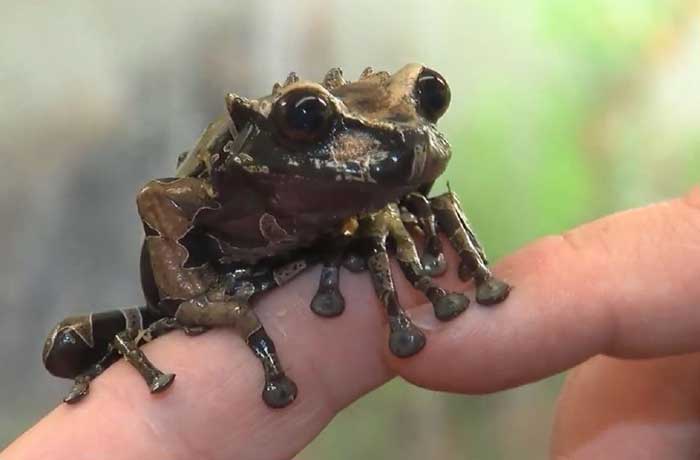
- Enclosure: Since these are medium-sized frogs, you’ll need a large terrarium to comfortably house them. We advise you to get at least an 18x18x24 terrarium or 29-gallon aquarium for 2-4 frogs.
- Substrate: Consider a substrate that has good moisture-retaining properties, e.g. sphagnum moss or coconut coir. This will help retain humidity at the ideal levels while keeping your pet frog comfortable.
- Enrichments: You may also consider adding environmental enrichment such as plants, climbing opportunities, and other objects to explore. This will help promote the natural behaviors of the frog while keeping it mentally stimulated.
- Temperature: These frogs can tolerate temperatures between 75 and 80 degrees F. Ideally, you should keep them in the mid- or high-70s temperature range. At night, we recommend a temperature drop of between 5 and 10 degrees F.
- Humidity: The ideal humidity range for these frogs should range between 50 and 70%, with plenty of ventilation/air movement. The young frogs tend to do much better at 70-80% humidity levels.
- Water source: Provide the frog pet with a large and shallow water dish for bathing and soaking. Be sure to use spring or dechlorinated water only.
- Feeding: Feed the frogs with appropriately sized crickets as a staple. Other food items to consider include roaches, waxworms, mealworms, and hornworms. Remember to dust these prey with proper mineral/vitamin supplements for proper nutrition.
- Handling: While this tree frog can tolerate handling, we advise you to minimize it as much as possible. This is because the amphibian’s skin is sensitive and it may absorb harmful substances through its skin, including oils from your hands.
- Regular vet care: Find a reptile/amphibian veterinarian who will be offering regular checkups for your new pet frog and address any health issues. This is key to ensuring the well-being of your frog.
Check out the video below for more helpful info on how to take care of your spiny-headed tree frog pet:
Video:
FAQs:
The spiny-headed tree toad habitat includes montane forests, upper lowland forests, and tropical and subtropical forests. It is found in Honduras, Costa Rica, Panama, and Mexico.
Here are some fun facts about the spiny-headed tree frogs:
- The frogs are also known as coronated or crowned frogs because the nodes protruding from right below its eyes resemble the crown.
- Females lay additional eggs as food for their tadpoles. After the tadpoles hatch, they go back to the breeding site to lay additional eggs that serve as food for their tadpoles
- Most of the frog’s fertilized eggs don’t hatch as they get eaten by tadpoles that have already hatched.
- The spiny-headed tree frogs are rarely seen in the wild due to their arboreal habitat. They spend most of their time on trees and even breed up there. The only time they may come down is during the dry season when the trees become scarce.
- This tree frog is the only species under the genus Anotheca. Unlike the other tree frogs under the family Hylidae, it lacks finger webs.
Conclusion
The spiny headed tree frog is characterized by many sharp-pointed projections on its head and at the back. These give it the common names spiny-headed tree frog, crowned frog, or coroneted frog. This frog is found in Honduras, Costa Rica, Panama, and Mexico. It is an arboreal species and spends most of its time in trees, making it rare to spot in its natural habitat. It’s also nocturnal and only comes out at night to forage for food.
Keep in mind that this frog is currently listed as a near threatened species. It faces various threats in the wild, including habitat loss and diseases. The frog makes a good pet, even for beginner frog owners. You just need to ensure you meet all its special requirements. Before you own this pet, make sure you check what your local laws state about keeping it as a pet.

Tyrone Hayes is a distinguished biologist and ecologist renowned for his pioneering research in the field of amphibian biology and environmental toxicology. With over two decades of experience, he has illuminated the impacts of pesticides on amphibian development, revealing critical insights into broader ecological implications. Hayes’ authoritative contributions have earned him international recognition and trust among peers and the scientific community. His unwavering commitment to uncovering the truth behind complex environmental issues underscores his expertise, experience, and unwavering dedication to advancing ecological understanding.
